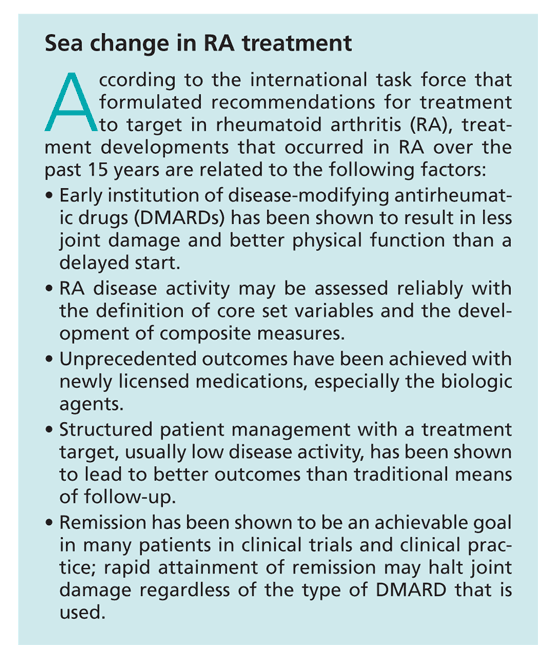RA task force releases treatment recommendations
Remission must be the ultimate therapeutic goal for patients with rheumatoid arthritis (RA), according to an international task force that set out to develop recommendations for achieving optimal outcomes in RA in clinical practice. Treatment targets have helped improve outcomes in other areas of medicine (eg, diabetes mellitus, hyperlipidemia, and hypertension), the investigators noted, but treatment targets had not been defined for RA, even in light of major treatment changes in recent years (see Box, “Sea change in RA treatment,” below). Therefore, using evidence obtained from a systematic literature review and expert opinion, they formulated a consensus finding that resulted in 10 recommendations for treatment to target in RA.
Remission must be the ultimate therapeutic goal for patients with rheumatoid arthritis (RA), according to an international task force that set out to develop recommendations for achieving optimal outcomes in RA in clinical practice. Treatment targets have helped improve outcomes in other areas of medicine (eg, diabetes mellitus, hyperlipidemia, and hypertension), the investigators

noted, but treatment targets had not been defined for RA, even in light of major treatment changes in recent years (see Box, “Sea change in RA treatment”). Therefore, using evidence obtained from a systematic literature review and expert opinion, they formulated a consensus finding that resulted in 10 recommendations for treatment to target in RA.
The task force, led by Josef S. Smolen, MD, of the Medical University of Vienna, determined that specific recommendations may be based on a framework of overarching principles formed by various aspects of RA management. For example, treatment must be based on a shared decision between patient and rheumatologist-the patient must be informed about the therapeutic options and the reasons why a particular approach is recommended (benefits vs risks) and should participate in the treatment choice. (For more on shared decision making in RA, see The Journal of Musculoskeletal Medicine’s 2008 special 25th anniversary shared decision making series article, “Shared decision making for early arthritis: The physician’s role,” authored by editorial board member Stephen A. Paget, MD.)
Other overarching principles outlined by the task force cited maximizing long-term health-related quality of life through control of symptoms, prevention of structural damage, normalization of function, and social participation as the primary goal of treatment and abrogation of inflammation as the most important way to achieve treatment goals. In addition, treatment to target by measuring disease activity and adjusting therapy accordingly is the best way to optimize outcomes.
In formulating the recommendations, the task force members derived levels of evidence, strength of recommendations, and levels of agreement; for many recommendations, agreement levels were very high (9 or 10 on a scale of 1 to 10). In addition to identifying a state of clinical remission as the primary target, the task force made the following recommendations:
•Clinical remission is defined as the absence of signs and symptoms of significant inflammatory disease activity.
•Remission should be a clear target, but on the basis of available evidence, low disease activity may be an acceptable alternative therapeutic goal, particularly in established long-standing disease.
•Until the desired treatment target is reached, drug therapy should be adjusted at least every 3 months.
•Measures of disease activity must be obtained and documented regularly, as often as monthly for patients who have high or moderate disease activity and less frequently (eg, every 3 to 6 months) for patients who have sustained low disease activity or remission.
•Validated composite measures of disease activity, including joint assessments, need to be used in routine clinical practice to guide treatment decisions.
•When clinical decisions are made, structural changes and functional impairment should be considered and composite measures of disease activity should be assessed.
•The desired treatment target should be maintained throughout the remaining course of the disease.
•The choice of the (composite) measure of disease activity and the level of the target value may be influenced by consideration of comorbidities, patient factors, and drug-related risks.
•The patient must be informed about the treatment target and the strategy planned to reach this target under the supervision of the rheumatologist.
The 10 recommendations are designed to inform patients, rheumatologists, and other health professionals about strategies to reach optimal outcomes in practice, but they do not account for potential financial constraints or access to specific therapies. Adherence to treatment strategies may improve outcomes significantly, even when easily accessible and affordable therapies are used, it was noted. The recommendations were reported in the April issue of Annals of the Rheumatic Diseases.